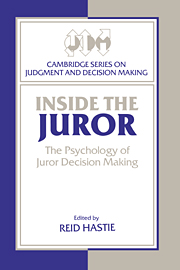Book contents
- Frontmatter
- Contents
- Series preface
- List of contributors
- Editor's preface
- Acknowledgments
- Part I Models of juror decision making
- Part II Commentaries
- 9 Notes on the sampling of stimulus cases and the measurement of responses in research on juror decision making
- 10 Sausages and the law: Juror decisions in the much larger justice system
- 11 A rational game theory framework for the analysis of legal and criminal decision making
- 12 Why do jury research?
- 13 Two conceptions of the juror
- 14 A mathematician comments on models of juror decision making
- Index of names
- Index of subjects
13 - Two conceptions of the juror
Published online by Cambridge University Press: 04 August 2010
- Frontmatter
- Contents
- Series preface
- List of contributors
- Editor's preface
- Acknowledgments
- Part I Models of juror decision making
- Part II Commentaries
- 9 Notes on the sampling of stimulus cases and the measurement of responses in research on juror decision making
- 10 Sausages and the law: Juror decisions in the much larger justice system
- 11 A rational game theory framework for the analysis of legal and criminal decision making
- 12 Why do jury research?
- 13 Two conceptions of the juror
- 14 A mathematician comments on models of juror decision making
- Index of names
- Index of subjects
Summary
Two contrasting theoretical conceptions have developed in recent research on jury decision making. I call these two alternate views of what goes on inside jurors’ heads the “meter model” and the “story model” (Figure 13.1). The meter model is based on the conception that inside the head are one or more mechanisms that continuously track, and can read out, one or more values that reflect the juror's current evaluation of the evidence. This view is probably the more popular theoretical position (subscribed to by Schum, Kerr, Casper, Dawes, Kadane, and Zabell, this book).
Usually the meter is conceived of as a unitary mechanism that reads out a quantity measuring the perceived guiltiness of the accused. However, the model can be easily elaborated to include separate meters, for example, for each of the elements of a criminal charge; a meter for identity, a meter for state of mind, and so forth. For Kerr (this book) the measure is the “quantity” of guilt that has accumulated in the juror's mind. For Casper (this book) it is the measure of convictability predicted by a linear regression equation. For Schum (this book) the meter actually generates probabilities or likelihood ratios measuring the goodness of evidence for alternate hypotheses (e.g., the defendant is guilty versus the defendant is not guilty).
In the story model (Pennington and Hastie, this book) the juror is depicted as having a cognitive structure that organizes individual facts (or things that the juror believes to be facts) and the relations among facts into a causal structure that explains how the events in question came about.
- Type
- Chapter
- Information
- Inside the JurorThe Psychology of Juror Decision Making, pp. 255 - 262Publisher: Cambridge University PressPrint publication year: 1993
- 1
- Cited by

